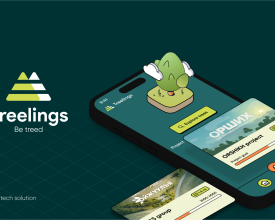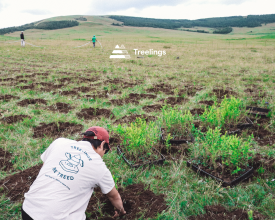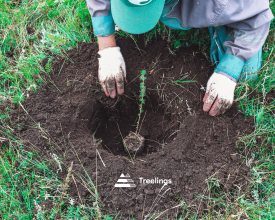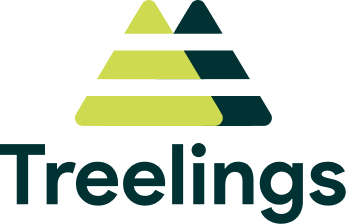
Treelings - Tree registration system
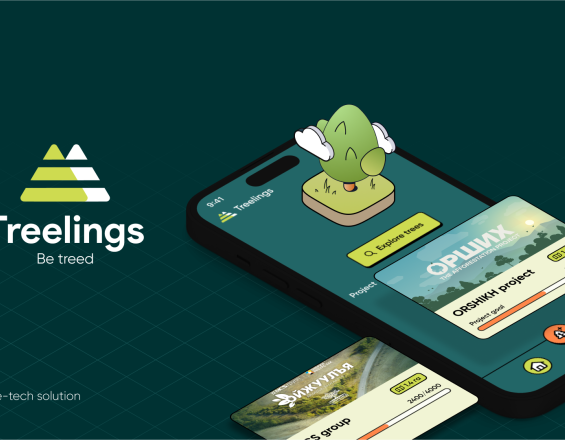
Treelings is a tree registration system that empowers individuals and organizations to plant trees and track their environmental impact — supporting nature-based carbon removal projects.
During the following 2 years of enlisting, the trees undergo regular monitoring through the use of drones, satellite images, and AI models to ensure their successful growth in the harsh climate of Mongolia. The process entails counting the number of trees, assessing the biomass, calculating carbon sequestration and checking their overall health with our algorithms. This information then gets recorded on blockchain and stays visible to their owners on the app and the website during their growth.
Since launching our MVP in 2022, our application has been downloaded 10000+ times and we are currently monitoring 89 thousand trees of 6 forestation projects on our platform. On top of developing a digital solution, we also directly overlook the plantation of 30,000 trees in a 20 hectares of area affected by desertification.
Context
Challenges addressed
Impacts of climate change in MONGOLIA
Mongolia is warming 3 times faster
- Between 1940 and 2015 Mongolia had a confirmed increase in temperature of 2.24°C making it “one of the strongest climate warming signals on Earth (IPCC)
Desertification of 77% of the land
- As of today over 77% of the land in Mongolia is affected by desertification and land degradation.
Air pollution poses severe health risks
- In Mongolia, indoor and outdoor air pollution account for 132 deaths per 100 000 people per year, whereas the global average is 92 deaths per 100 000 people (WHO)
Location
Process
Summary of the process
The Digital MRV system provides transparent monitoring data, which feeds directly into the Blockchain-Verified Tree Registry, ensuring that certificates and digital IDs are backed by credible evidence. This transparency is crucial for attracting corporate partners, who require verified impact metrics for their CSR/ESG strategies. At the same time, the three-year maintenance and survival guarantee ensures that the data monitored and certificates issued reflect real, long-term results rather than short-term planting activities.
On the ground, the youth volunteer engagement model and the community education and reward system strengthen local ownership, creating the human infrastructure needed to maintain and protect the planted trees. These social models ensure that the digital systems are not operating in isolation but are rooted in community stewardship.
Building Blocks
Digital MRV (Measurement–Reporting–Verification) System
- What it is: AI-powered monitoring platform combining drones, satellite imagery, and blockchain verification.
- Why it matters: Ensures transparency, traceability, and credibility of every planted tree.
- Transferability: Can be adapted to monitor other nature-based solutions (wetlands, grasslands, mangroves, etc.).
Enabling factors
Purpose:
To ensure that every tree planted is measurable, reportable, and verifiable in a transparent way. It solves the credibility gap in reforestation projects, where funders often cannot confirm survival or carbon impact.
How it works:
Treelings deploys drones and satellites to capture high-resolution imagery. AI algorithms detect tree survival, growth, and canopy cover. These data points are stored and shared through a user dashboard. The system reduces manual error, provides near-real-time monitoring, and can be adapted to other ecosystems.
Lesson learned
Enabling Conditions:
- Reliable internet and cloud infrastructure for data transfer and storage.
- Access to drones, satellite imagery, and AI/remote sensing expertise.
- Technical capacity for system calibration and algorithm training.
- Open collaboration with local authorities for field data validation.
Blockchain-Verified Tree Registry & Certificates
- What it is: Each planted tree is assigned a digital ID and certificate stored on blockchain.
- Why it matters: Builds trust with funders, companies, and individuals by proving tree ownership and survival.
- Transferability: Applicable to carbon markets, biodiversity credits, or ecosystem services accounting.
Lesson learned
Enabling Conditions:
- A functioning blockchain environment and smart contract platform.
- Partnerships with IT developers and registry operators.
- Clear project metadata (species, GPS coordinates, planting date).
- Stakeholder willingness to adopt digital certification instead of traditional paperwork.
Youth Volunteer Engagement Model
- What it is: Mobilization of students and local youth (e.g., “Green Volunteers”) for tree planting, maintenance, and awareness-building.
- Why it matters: Builds long-term stewardship and community ownership of restored areas.
- Transferability: Can be replicated for climate education, waste management, or community energy projects.
Enabling factors
Enabling Conditions:
- Strong partnerships with schools, universities, and youth NGOs.
- Training and safety guidelines for fieldwork.
- Incentive structures (certificates, recognition, or small stipends).
- Community support to integrate youth efforts into broader reforestation projects.
Corporate Partnership & CSR Integration
- What it is: Businesses (telecom, finance, events, resorts, etc.) co-finance tree groves as part of CSR/ESG strategies.
- Why it matters: Provides sustainable funding for reforestation while aligning with companies’ branding and SDG goals.
- Transferability: Can be applied to other green initiatives (renewables, circular economy, eco-labels).
Enabling factors
- Corporate buy-in and alignment with ESG/SDG reporting frameworks.
- Transparent communication of impact metrics (e.g., survival rates, CO₂ captured).
- Marketing/branding benefits clearly outlined for partners.
- Legal agreements covering co-branding, funding flows, and monitoring obligations.
Three-Year Maintenance & Survival Guarantee
- What it is: Each planting project includes watering, fencing, and maintenance for at least 3 years.
- Why it matters: Addresses high mortality rates in tree planting, ensuring long-term carbon sequestration.
- Transferability: Maintenance-first approach can be adopted in agriculture, conservation, or infrastructure projects.
Enabling factors
- Upfront financing that includes maintenance costs, not just planting.
- Reliable local partners to execute watering, fencing, and replanting.
- Monitoring protocols (app reports, drone flights, survival surveys).
- Community involvement to reduce risks of neglect or damage.
Community Education & Reward System
- What it is: Local residents and households (e.g., ger districts) participate and receive recognition, small rewards, or utility discounts.
- Why it matters: Incentivizes grassroots climate action and strengthens community buy-in.
- Transferability: Rewards model can support recycling, clean cooking, or water conservation programs.
Enabling factors
- Collaboration with local authorities and utilities to provide rewards (discounts, recognition).
- Simple, accessible communication materials (visuals, local language).
- Mechanisms for households to record participation (e.g., app, QR codes).
- Ongoing awareness campaigns to maintain motivation.
Impacts
Since launching our MVP in 2022, our application has been downloaded 10000+ times and we are currently monitoring 89 thousand trees of 6 forestation projects on our platform. On top of developing a digital solution, we also directly overlook the plantation of 30,000 trees in a 20 hectares of area affected by desertification.
Beneficiaries
- Local projects developers (Tree planting team)
- Individuals who wants to take some actions for climate change or local climate issues
- Companies for SDG goals
- Organizations
Global Biodiversity Framework (GBF)
Sustainable Development Goals
Story
In the autumn of 2023, a young university student in Ulaanbaatar named Anu joined a tree-planting event on the dusty slopes of Bayanzurkh district. Like many young people in the city, she had grown up hearing about desertification and worsening air pollution, but had never felt she could make a real difference.
When she arrived, she expected to simply dig a hole, plant a sapling, and go home. Instead, she was handed a smartphone with the Treelings app, where every tree was registered with GPS coordinates, species data, and a digital certificate. A drone flew overhead, capturing images for the monitoring system. The organizer explained that the tree she planted would not disappear into uncertainty; it would be measured, reported, and verified for years to come.
For Anu, this was a turning point. She could now see her impact in real time, track her tree’s survival, and share the certificate with her friends. She later became a volunteer leader, mobilizing classmates to join. What began as “just another student activity” grew into a sense of pride: she and her peers were part of building a transparent, tech-enabled climate solution for Mongolia.
The benefits were not only personal. The community around Bayanzurkh began to notice that the new groves were thriving because of three-year maintenance guarantees. Local companies, impressed by the transparent monitoring, joined in to sponsor larger planting projects. What once felt like symbolic tree-planting became a movement where youth, communities, and businesses all had a role — each supported by Treelings’ building blocks of technology, trust, and long-term care.
Today, Anu often says:
“Before Treelings, I planted trees and never knew what happened after. Now I know that my tree is alive — and that gives me the courage to believe we can restore Mongolia’s landscapes.”

